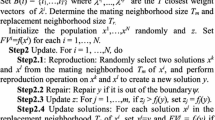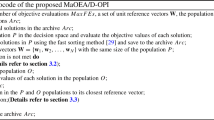Abstract
In the domain of science and engineering optimization, many-objective problems have posed great challenges during the last few years. In response to this, several algorithms have been proposed that include generic as well as specific approaches for problem-solving. This paper proposes an improved evolutionary many-objective optimization (EMaO) method, MOSA/D, which is a Multi-Operator approach with Self-Adaptation of parameters based on Decomposition. It is a generic method based on the framework of the MOEA/D algorithm and aimed to explore the role of an ensemble of differential evolution operators for optimizing many-objective problems in the decomposition environment. Another contribution of this study is the detection of the start of the exploitation stage of evolution to enable the fine-tuning of solutions. The simulation studies involve comparing our approach with some selected state-of-the-art algorithms on standard test problems having 5-, 8-, 10-, 12- and 15-objective spaces. The experimental results show that the proposed MOSA/D is overall superior to other approaches in terms of attaining the convergence and diversity of solutions.











Similar content being viewed by others
Data Availability
All data generated or analyzed during this study are included in this published article as different tables.
Notes
For DTLZ problems
References
Deb K, Jain H (2014) An evolutionary many-objective optimization algorithm using reference-point-based nondominated sorting approach, part i: Solving problems with box constraints. IEEE Trans Evol Comput 18(4):577–601
Denysiuk R, Costa L, Espírito Santo I (2013) Many-objective optimization using differential evolution with variable-wise mutation restriction. In: Proceedings of the 15th annual conference on Genetic and evolutionary computation. ACM, pp 591–598
Ishibuchi H, Tsukamoto N, Nojima Y (2008) Evolutionary many-objective optimization: A short review. In: Evolutionary Computation, 2008. CEC 2008.(IEEE World Congress on Computational Intelligence). IEEE Congress on. IEEE, pp 2419–2426
Coello CAC, Lamont GB, Van Veldhuizen DA et al (2007) Evolutionary algorithms for solving multi-objective problems, vol 5. Springer, Berlin
Li M, Yang S, Li K, Liu X (2014) Evolutionary algorithms with segment-based search for multiobjective optimization problems. IEEE Trans Cybernet 44(8):1295–1313
Zheng W, Tan Y, Meng L, Zhang H (2018) An improved moea/d design for many-objective optimization problems. Appl Intell 48(10):3839–3861
Qasim SZ, Ismail MA (2020) Rode: Ranking-dominance-based algorithm for many-objective optimization with opposition-based differential evolution. Arab J Sci Eng pp. 1–18
Zhang Y, Wang G-G, Li K, Yeh W-C, Jian M, Dong J (2020) Enhancing moea/d with information feedback models for large-scale many-objective optimization. Inform Sci 522:1–16
Silva R, Salimi A, Li M, Freitas AR, Guimarães FG, Lowther DA (2015) Visualization and analysis of tradeoffs in many-objective optimization: a case study on the interior permanent magnet motor design. IEEE Trans Magnet 52(3):1–4
Mkaouer MW, Kessentini M, Bechikh S, Deb K, Ó Cinnéide M (2014) High dimensional search-based software engineering: finding tradeoffs among 15 objectives for automating software refactoring using nsga-iii. In: Proceedings of the 2014 Annual Conference on Genetic and Evolutionary Computation. ACM, pp 1263–1270
Kremmel T, Kubalík J, Biffl S (2011) Software project portfolio optimization with advanced multiobjective evolutionary algorithms. Appl Soft Comput 11(1):1416–1426
Qasim SZ, Ismail MA (2017) Research problems in search-based software engineering for many-objective optimization. In: Innovations in Electrical Engineering and Computational Technologies (ICIEECT), 2017 International Conference on. IEEE, pp 1–6
Ramirez A, Romero JR, Ventura S (2019) A survey of many-objective optimisation in search-based software engineering. J Syst Softw 149:382–395
Sayyad AS, Menzies T, Ammar H (2013) On the value of user preferences in search-based software engineering: a case study in software product lines. In: Proceedings of the 2013 International Conference on Software Engineering. IEEE Press, pp 492–501
Bowman M, Briand LC, Labiche Y (2010) Solving the class responsibility assignment problem in object-oriented analysis with multi-objective genetic algorithms. IEEE Trans Softw Eng 36(6):817–837
Razmjooy N, Ashourian M, Foroozandeh Z (2020) Metaheuristics and Optimization in Computer and Electrical Engineering. Springer, Berlin
Sülflow A, Drechsler N, Drechsler R (2007) Robust multi-objective optimization in high dimensional spaces. In: International conference on evolutionary multi-criterion optimization. Springer, pp 715–726
Deb K, Pratap A, Agarwal S, Meyarivan T (2002) A fast and elitist multiobjective genetic algorithm: Nsga-ii. IEEE Trans Evol Comput 6(2):182–197
Zitzler E, Laumanns M, Thiele L (2001) Spea2: Improving the strength pareto evolutionary algorithm. TIK-report, vol 103
Deb K, Jain H (2012)Handling many-objective problems using an improved nsga-ii procedure. In: 2012 IEEE Congress on Evolutionary Computation. IEEE, pp 1–8
Purshouse RC, Fleming PJ (2003) Evolutionary many-objective optimisation: An exploratory analysis. In: The 2003 Congress on Evolutionary Computation, 2003. CEC’03., vol 3. IEEE, pp 2066–2073
Garza-Fabre M, Pulido GT, Coello CAC (2009) Ranking methods for many-objective optimization. In: Mexican International Conference on Artificial Intelligence. Springer, pp 633–645
López Jaimes A, Coello Coello CA (2009) Some techniques to deal with many-objective problems. In: Proceedings of the 11th Annual Conference Companion on Genetic and Evolutionary Computation Conference: Late Breaking Papers, pp 2693–2696
Deb K, Agrawal RB et al (1995) Simulated binary crossover for continuous search space. Complex Syst 9(2):115–148
Mnasri S, Nasri N, Van den Bossche A, Val T (2019) Improved many-objective optimization algorithms for the 3d indoor deployment problem. Arab J Sci Eng 44(4):3883–3904
Li Z, Lin K, Nouioua M, Jiang S, Gu Y (2019) Dcdg-ea: dynamic convergence-diversity guided evolutionary algorithm for many-objective optimization. Exp Syst Appl 118:35–51
Wang Y, Cai Z, Zhang Q (2011) Differential evolution with composite trial vector generation strategies and control parameters. IEEE Trans Evol Comput 15(1):55–66
Li K, Fialho A, Kwong S, Zhang Q (2013) Adaptive operator selection with bandits for a multiobjective evolutionary algorithm based on decomposition. IEEE Trans Evol Comput 18(1):114–130
Fan Q, Yan X (2015) Self-adaptive differential evolution algorithm with zoning evolution of control parameters and adaptive mutation strategies. IEEE Trans Cybernet 46(1):219–232
Lin Q, Liu Z, Yan Q, Du Z, Coello CAC, Liang Z, Wang W, Chen J (2016) Adaptive composite operator selection and parameter control for multiobjective evolutionary algorithm. Inform Sci 339:332–352
Xie Y, Qiao J, Wang D, Yin B (2020) A novel decomposition-based multiobjective evolutionary algorithm using improved multiple adaptive dynamic selection strategies. Information Sciences
Storn R, Price K (1997) Differential evolution-a simple and efficient heuristic for global optimization over continuous spaces. J Glob Optimiz 11(4):341–359
Razmjooy N, Khalilpour M, Ramezani M (2016) A new meta-heuristic optimization algorithm inspired by fifa world cup competitions: theory and its application in pid designing for avr system. J Control, Autom Electric Syst 27(4):419–440
Gong W, Razmjooy N (2020) A new optimisation algorithm based on ocm and pcm solution through energy reserve. Int J Am Energy pp. 1–14
Razmjooy N, Estrela VV, Loschi HJ (2020) Entropy-based breast cancer detection in digital mammograms using world cup optimization algorithm. Int J Swarm Intell Res (IJSIR) 11(3):1–18
Das S, Suganthan PN (2010) Differential evolution: a survey of the state-of-the-art. IEEE Trans Evol Comput 15(1):4–31
Das S, Mullick SS, Suganthan PN (2016) Recent advances in differential evolution-an updated survey. Swarm and Evol Comput 27:1–30
Miettinen K (2012) Nonlinear Multiobjective Optimiz, vol 12. Springer Science & Business Media, Berlin
Zhang Q, Li H (2007) Moea/d: a multiobjective evolutionary algorithm based on decomposition. IEEE Trans Evol Comput 11(6):712–731
Li H, Zhang Q (2009) Multiobjective optimization problems with complicated pareto sets, moea/d and nsga-ii. IEEE Trans Evol Comput 13(2):284–302
Li K, Fialho A, Kwong S, Zhang Q (2014) Adaptive operator selection with bandits for a multiobjective evolutionary algorithm based on decomposition. IEEE Trans Evol Comput 18(1):114–130
Sindhya K, Miettinen K, Deb K (2013) A hybrid framework for evolutionary multi-objective optimization. IEEE Trans Evol Comput 17(4):495–511
Li K, Zhang Q, Kwong S, Li M, Wang R (2014) Stable matching-based selection in evolutionary multiobjective optimization. IEEE Trans Evol Comput 18(6):909–923
Li K, Deb K, Zhang Q, Kwong S (2015) An evolutionary many-objective optimization algorithm based on dominance and decomposition. IEEE Trans Evol Comput 19(5):694–716
Bi X, Wang C (2017) An improved nsga-iii algorithm based on elimination operator for many-objective optimization. Memet Comput 9(4):361–383
Eiben AE, Smith JE et al (2003) Introduction to evolutionary computing, vol 53. Springer, Berlin
Eiben ÁE, Hinterding R, Michalewicz Z (1999) Parameter control in evolutionary algorithms. IEEE Trans Evol Comput 3(2):124–141
Eiben AE, Michalewicz Z, Schoenauer M, Smith JE (2007) Parameter control in evolutionary algorithms. In: Parameter setting in evolutionary algorithms. Springer, pp 19–46
Karafotias G, Hoogendoorn M, Eiben ÁE (2015) Parameter control in evolutionary algorithms: Trends and challenges. IEEE Trans Evol Comput 19(2):167–187
Ma X, Yu Y, Li X, Qi Y, Zhu Z (2020) A survey of weight vector adjustment methods for decomposition-based multiobjective evolutionary algorithms. IEEE Trans Evol Comput 24(4):634–649
Qin AK, Huang VL, Suganthan PN (2009) Differential evolution algorithm with strategy adaptation for global numerical optimization. IEEE Trans Evol Comput 13(2):398–417
Wu G, Mallipeddi R, Suganthan PN, Wang R, Chen H (2016) Differential evolution with multi-population based ensemble of mutation strategies. Inf Sci 329:329–345
Bäck T, Fogel DB, Michalewicz Z (2018) Evolutionary computation 1: Basic algorithms and operators. CRC Press, USA
Hui S, Suganthan PN (2015) Ensemble and arithmetic recombination-based speciation differential evolution for multimodal optimization. IEEE Trans Cybernet 46(1):64–74
Nebro AJ, Durillo JJ (2013) jmetal 4.3 user manual. available from Computer Science Department of the University of Malaga
Durillo JJ, Nebro AJ, Alba E (2010) The jmetal framework for multi-objective optimization: Design and architecture. In: 2010 IEEE Congress on Evolutionary Computation (CEC). IEEE, pp 1–8
Durillo JJ, Nebro AJ (2011) jmetal: a java framework for multi-objective optimization. Adv Eng Softw 42(10):760–771
Deb K, Thiele L, Laumanns M, Zitzler E (2005) Scalable test problems for evolutionary multiobjective optimization. In: Evolutionary multiobjective optimization. Springer, pp 105–145
Cheng R, Li M, Tian Y, Xiang X, Zhang X, Yang S, Jin Y, Yao X (2018) Benchmark functions for the cec’2018 competition on many-objective optimization. Tech. Rep
Knowles JD, Thiele L, Zitzler E (2006) A tutorial on the performance assessment of stochastic multiobjective optimizers. TIK-Report, vol 214
Ishibuchi H, Masuda H, Tanigaki Y, Nojima Y (2015) Modified distance calculation in generational distance and inverted generational distance. In: International conference on evolutionary multi-criterion optimization. Springer, pp 110–125
Yuan Y, Xu H, Wang B (2014) An improved nsga-iii procedure for evolutionary many-objective optimization. In: Proceedings of the 2014 Annual Conference on Genetic and Evolutionary Computation. ACM, pp 661–668
Coello CAC, Cortés NC (2005) Solving multiobjective optimization problems using an artificial immune system. Genet Program Evolvable Mach 6(2):163–190
Price K, Storn RM, Lampinen JA (2006) Differential evolution: a practical approach to global optimization. Springer Science & Business Media, Berlin
Demšar J (2006) Statistical comparisons of classifiers over multiple data sets. J Mach Learn Res 7(Jan):1–30
Gong W, Zhou A, Cai Z (2015) A multioperator search strategy based on cheap surrogate models for evolutionary optimization. IEEE Trans Evol Comput 19(5):746–758
He Z, Yen GG, Zhang J (2014) Fuzzy-based pareto optimality for many-objective evolutionary algorithms. IEEE Trans Evol Comput 18(2):269–285
Deb K (2001) Multi-objective optimization using evolutionary algorithms, vol 16. John Wiley & Sons, New Jersey
Funding
This work was supported by the MoST (Ministry of Science & Technology) endowment and NED University research grants.
Author information
Authors and Affiliations
Corresponding author
Ethics declarations
Conflict of interest
Present employment
Code availability
As mentioned earlier, code is developed in Java using jMetal framework and is available with the authors.
Additional information
Publisher's Note
Springer Nature remains neutral with regard to jurisdictional claims in published maps and institutional affiliations.
Rights and permissions
About this article
Cite this article
Qasim, S.Z., Ismail, M.A. MOSA/D: Multi-operator evolutionary many-objective algorithm with self-adaptation of parameters based on decomposition. Evol. Intel. 16, 849–871 (2023). https://doi.org/10.1007/s12065-021-00698-4
Received:
Revised:
Accepted:
Published:
Issue Date:
DOI: https://doi.org/10.1007/s12065-021-00698-4




